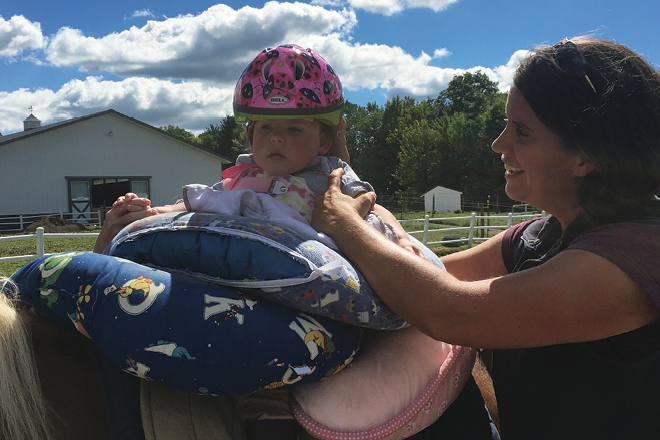Article by Karen Illig, Pine Crest School
Photo courtesy of Lothlorien Therapeutic Riding Center. A volunteer (not Illig) assists a child at Lothlorien.
One of my favorite sayings is by poet John Anthony Davies, and I think it best describes why I love to work with therapeutic horses and their riders:
I saw a child born into strife
take up and hold the reins of life,
and that same child was heard to say
“Thank you for showing me the way.”
Growing up on a hunter-jumper horse farm south of Buffalo, New York spurred my lifelong love of the 2,000-pound animals. My mom was an educator with an eye for a good horse, and my dad was a World War II Navy veteran and engineer who loved competitive sports. Stabling and showing horses was something they enjoyed doing together — and teaching their children. For me that meant many responsibilities, such as early morning feedings, stall and tack cleaning, riding and training multiple horses daily, grooming, braiding and even medical care.
While I enjoyed traveling and competing on the national horse show circuit, I’ve found my most rewarding equine experiences while volunteering at the Lothlorien Therapeutic Riding Center near our family farm. The name comes from J.R.R. Tolkien’s work — it is the finest realm in Elven territory — and means “the land of flowering dreams.”
Like its namesake, the therapeutic riding center is a magical place. Volunteers teach children and adults with cognitive, emotional, physical and learning challenges to achieve their highest potential through horseback riding. It is a place of phenomenal commitment, profound connections, laughter and joy for instructors, volunteers, students and parents alike. I love observing the horses’ instinct and sentient understanding when they assist special people who return their love, warmth and kindness. Therapeutic horses are usually older, quieter servants who are given a second career. They have to pass a service test to earn the opportunity to be gentle and bond with their human partner.
A horse’s walking action mimics that of a human, and this gives walking-impaired riders the sensation that they are walking themselves.
The medical benefits of therapeutic riding are immense. A horse’s walking action mimics that of a human, and this gives walking-impaired riders the sensation that they are walking themselves. I recall one of my youngest students, only five, who was born with a chromosomal abnormality. His parents were told he would never be able to walk, yet through riding he progressed to strengthening his legs and standing up in his stirrups. His ultimate goal, and ours, is for him to walk out of the ring after his riding lesson.
Therapeutic riding benefits riders with muscular dystrophy, multiple sclerosis, cerebral palsy, blindness, stroke complications, ADD and ADHD, Parkinson’s and brain injuries. During riding lessons, instructors tailor exercises and games to address each rider’s unique needs. We work on speech exercises for those with verbal challenges and use sign language as an alternate communication method. Therapeutic riding benefits include improvement in posture, balance, joint movement and, perhaps most striking, morale.
Riders with emotional and behavioral needs learn ways to connect with their equine partner. I’ve witnessed a horse befriend a withdrawn child and rekindle her willingness to trust again. I’ve also seen how therapeutic riding improves a child’s attention span, confidence, self-image and cooperation with others. In fact, this physical and emotional connection with a supportive, loving horse can truly heal an injured body, mind and spirit. Leaving wheelchairs and walkers behind, our riders embark on a journey with their equine partner they couldn’t do alone.
There are thousands of accredited riding centers around the world. More than 800 U.S. centers need volunteers to walk alongside riders on both sides and then another person to lead the horse. It’s a wonderful opportunity for students to earn community service credits. For more information, visit the website of the Professional Association of Therapeutic Horsemanship International.
Karen Illig is vice president of finance and operations and chief financial officer at Pine Crest School, a preK-12 day school with campuses in Fort Lauderdale and Boca Raton, Florida.
Download a PDF of the article.



